Over the past few weeks, I have been highlighting all of the blog redesigns we have been rolling out in the office. If you are here reading this, you are already familiar with The Big Picture and probably know Josh’s Reformed Broker. Ben, Josh, Mike, Tony as well as this site have all received a thorough update — light, fast loading, mobile-friendly (up next is Kris).
I have consistently been asked by people over the past decade “Why bother doing this?” Why go through all of the effort, time, and expense to publish specific research, analyze markets and investor behavior, and then publish it — for free?
To fully answer that question, we need to place what we do in the context of Wall Street’s traditional business model for research.
Not too long ago, company-specific, market, and economic research played a significant role in Wall Street’s financial ecosystem. All of the large bulge bracket brokerage firms (and most of the rest) had a robust research department. They would release reports on specific companies, analyze broad market trends, discuss the state of the economy. It was the destination job on Wall Street for wonks coming out of school, a glamorous gig for MBAs and CFAs.
And, it attracted enormous fees from clients:
- Institutional firms at one time paid 15 cents/share and higher as trading commissions. This got them detailed company analysis, and so much more: Access to the early calls on any market-moving news tracked by analysts that might not immediately be available publicly. Upgrades and downgrades, changes in earnings forecasts, whisper numbers all helped mutual funds, hedge funds, pension funds and endowments add Alpha;
- Underwriting raised investment capital from the investing public on behalf of public firms by issuing securities (IPO, secondaries.) and debt (Bond issuance); Clients clamored for the hot issues, it grew into a huge profit center;
- Mergers & Acquisitions counsel was provided for companies in terms of structuring deals, financing them, evaluating their fairness, etc.
- Private banking was offered to executives at all of the above-covered firms. This included everything from managing their own internal ESOP to assets for the execs.
All of the above is a perfectly valid approach to making money and servicing clients; it used to be extremely lucrative. Today, it is a service and a moneymaker, but far less so than it once was.
But what is most noteworthy about this is what’s missing from the list: Serving the investing public. It is not found anywhere on that list, as that was never the business model of Wall Street. Indeed, as we learned during the analyst scandals following dotcom collapse, oftentimes, the public was not only not served, but done an active disservice. That is not a valid way to do business in financial services.
Over the ensuing 15 years, the world changed. Adapt or Die was the internet’s challenge, as everyone’s business model was threatened. Media slashed budgets; insightful economic and market analysis was in short supply, even Wall Street changed up its research model.
It was into that environment that this blog was born. The initial intentions were modest, without fantasies of disrupting the big guys. It was simply a quiet place to express some thoughts and to explore a few ideas.
But the world was rapidly changing. Blogs became a place where people went to get insight and expert opinions on issues they were not hearing from Wall Street research or mainstream media. Straightforward analysis — with no promise of a commission transaction or compensation of any sort — freed up authors to write about whatever they wanted, however they wanted.
If people read it or not was almost besides the point as sites became a forum for the honest exploration of important finance, economic, market and investing topics. It was a big deal when we achieved 20,000 and then 100,000 hits. Leading up to the financial crisis, readers found a rich ecosystem discussing ideas that had never really gotten past the gatekeepers in traditional media or finance.
Which leads me to our present business model.
If the precise opposite of the Wall Street version discussed above can be imagined, that’s what ours would look like. If theirs looks is a pyramid — highest gross fees at the top, huge numbers of lower fee-paying at the bottom & the vast majority of their research clients paying them for access to password-gated content along with all manner of ancillary services — ours is free.
We (Me, Josh, Ben, Mike, Tony, Kris as well as other guests) give away lots of insightful perspectives on markets and investing without any expectations of compensation from the vast majority of our readers. Its an inverted pyramid.
We hope to accomplish numerous things by this process:
…• Educate readers as to what is actually going on in the markets and the economy — and what it means;
…• Teach people a smart way to invest their own money;
…• Explain the risks their own actions create from a behavioral perspective;
…• Reveal the many ways The Street can take advantage of them;
…• Explain to even sophisticated institutional investors how they should best position their portfolios;
…• Have an intelligent debate about the larger regulatory issues covering this field;
…• Explain investing with a historical, data-driven, evidence-based approach.
We do this because we are driven by a fire within that compels us to do it. We know too much about the wrong ways things are done in our profession, ranging from conflicted advice to overpriced products to the myriad ways salespeople use fear and greed to separate unsuspecting folks from their money.
I used to say (only half-jokingly) I blog “to help quiet down the voices in my head.” But many a truth is spoken in jest. The nonsense and frustrations we all witness in this industry every day is a red hot ember that drives us, a prime motivator to push back against the endless firehose of bullshit that the Wall Street machinery manufactures. The single biggest and most profitable product that the Finance Factory cranks out every day is bullshit, and each version of it is slicker and better, and more dangerous than whatever came before. Bullshit 3.0 caused the financial crisis, I lose sleep worrying about what Bullshit 4.0 is going to do.
To answer our original question: Our research business model is to create a countervailing narrative to this endless flow of money-losing foolishness. We know that not everyone will be saved, but we can at least provide enough information, data, and commentary that an intelligent web-surfing investor can find ways to save themselves from the Finance Factory’s finest foolery.
I assume some small percentage of readers might think, “Hey, these guys are smart, they know what the real deal is, I’d like them to manage my assets.”
If 1% of readers become clients of RWM, that would be lovely (reach us at info-at-ritholtzwealth.com). In the meanwhile, we end up sharing lots of great insight with the public who desperately need something better than what they have been force-fed.
If we can do well by doing good, that is a model I believe we can not only live with, but be proud of also.

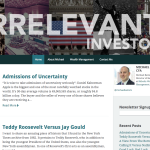
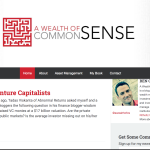

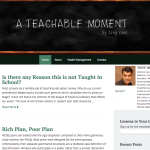
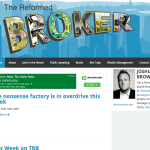
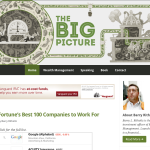

What's been said:
Discussions found on the web: